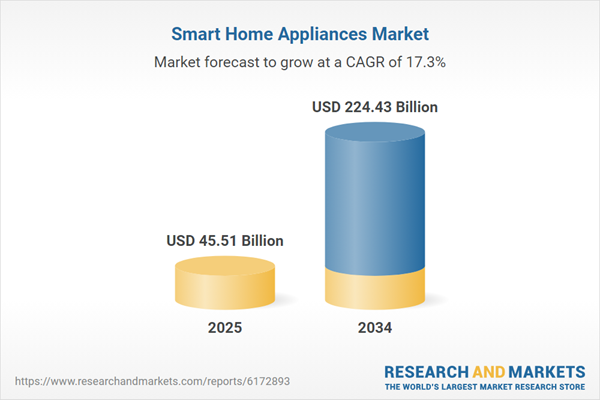North America and the Asia-Pacific to Significantly Aid the Smart Home Appliances Industry
The North America and the Asia-Pacific regions are significantly supporting the growth of the global market for smart home appliances. Some of the largest consumer markets within the Asia-Pacific region include India and China due to the increasing internet penetration and technology advancements in these developing economies. The main factors that are driving the demand within the smart appliances industry in the Asia-Pacific are the adoption of cloud technologies, increase in awareness related to safety and security, rising standards of living and disposable incomes of the people living therein, increasing government investments in smart cities, continuous expansion of high-speed Internet in the regions, and access to these systems in the region.The rising investments in smart grid projects and the acceptance of the products by the consumers are driving the market's significant expansion within the North America region. Smart homes have gained prominence in North America, which has further driven the revenues in the smart home appliances industry in the region. Apart from the Asia-Pacific and North America, Europe is also registering a robust consumption of smart home appliances and is likely to be among the leading regions in the coming years.
Impact of COVID-19 on the Global Market for Smart Home Appliances
The COVID-19 pandemic had both positive and negative impact on the market for smart appliances. Because of the COVID-19 pandemic, the demand for smart appliances such as refrigerators, washing machines, and other similar items witnessed an increase. As consumers worked from home and spent more time at home necessitates, they adopted appliances that can complete these tasks quickly compared to traditional methods. However, due to the COVID-19 pandemic, the manufacturing capabilities of all the regions were negatively affected due to halted production amidst lockdown restrictions leading to the supply of the products from manufacturers to end-users being decreased dramatically. This adversely impacted the market growth during the pandemic.Smart Home Appliances: Market Segmentation
Smart home appliances are devices installed in a smart home and work with home automation technology that uses electric power transmission with short radio frequency signals. They make use of open-source and proprietary software and distributed denial-of-service attacks (DDoS). Smart home appliances have a wide range of uses in the home. The main goal of the appliances is to increase customer comfort and improve user experience in the residential sector.By product type, the market can be divided into:
- Smart Ovens
- Smart Dishwashers
- Smart Refrigerators
- Smart Cookware and Cooktops
- Smart Scale and Thermometers
- Others
The regional markets for smart home appliances can be divided into:
- North America
- Europe
- Asia-Pacific
- Latin America
- Middle East and Africa
Rising Demand for Smart Phones and Increase in Internet Penetration Boosting the Market Growth
The smart appliance industry has been witnessing a significant growth since the historical period owing primarily to the rising smartphone demand and increased internet penetration. Users are drawn to smart appliances because of the ease with which they can monitor them using their smartphones or tablets. The rising adoption of the appliances has also been driven by the significant benefit of connecting all the home appliances to the internet through a single interface.The growing popularity of home improvement projects in Western countries is paving the way for various smart products for residential use. In the coming years, the growth of the smart appliances industry is expected to be significantly driven by the increasing consumer preference for video doorbells, voice-assisted technologies (such as Alexa and Google Home), and surveillance systems. In addition, smart home appliances are changing as a result of IoT advancements. IoT will allow various appliances, such as lighting, home appliances, computers, and security cameras, to communicate, which is further projected to propel the growth of the market.
With most businesses shifting their traditional practices toward IoT, it is expected to reach numerous application areas such as lighting, healthcare, security, and entertainment. The rise in wireless solutions' availability is, thus, expected to boost the smart home appliances industry growth in the coming years considerably. Home appliances such as refrigerators, washing machines, and other appliances that can be controlled using a smart device while also incorporating smart systems are expected to be the key applications of smart home appliances that are anticipated to see a significant growth.
Key Industry Players in the Global Smart Home Appliances Market
The report gives a detailed analysis of the following key players in the global smart home appliances market, covering their competitive landscape, capacity, and latest developments like mergers, acquisitions, and investments, expansions of capacity, and plant turnarounds:- LG Electronics Inc.
- AB ELECTROLUX
- Whirlpool Corporation
- Samsung Electronics Co., Ltd.
- BSH Hausgeräte GmbH
- Panasonic Corporation
- Others
Table of Contents
Companies Mentioned
The key companies featured in this Smart Home Appliances market report include:- LG Electronics Inc.
- AB ELECTROLUX
- Whirlpool Corporation
- Samsung Electronics Co., Ltd.
- BSH Hausgeräte GmbH
- Panasonic Corporation
Table Information
| Report Attribute | Details |
|---|---|
| No. of Pages | 174 |
| Published | August 2025 |
| Forecast Period | 2025 - 2034 |
| Estimated Market Value ( USD | $ 45.51 Billion |
| Forecasted Market Value ( USD | $ 224.43 Billion |
| Compound Annual Growth Rate | 17.3% |
| Regions Covered | Global |
| No. of Companies Mentioned | 7 |









